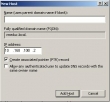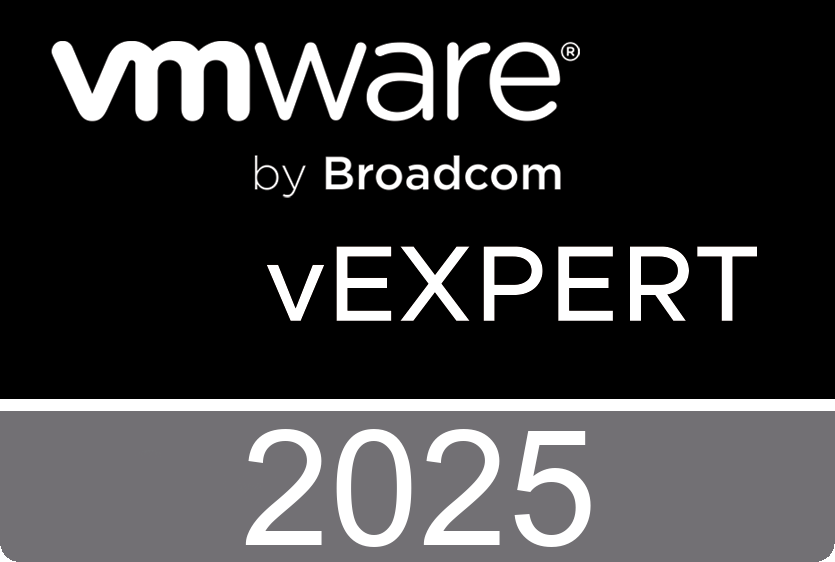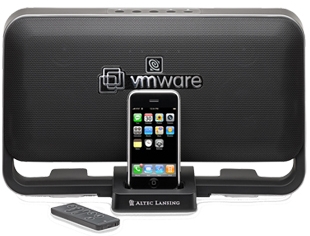 VMware has launched a new campaign, when you are still a VCP on 2.5 you have the opportunity to be updated to VCP for VI3.5 and rock the world. If you’re one of the first 100 to pass before February 28th. VMware will give you an Altec Lansing T612.
VMware has launched a new campaign, when you are still a VCP on 2.5 you have the opportunity to be updated to VCP for VI3.5 and rock the world. If you’re one of the first 100 to pass before February 28th. VMware will give you an Altec Lansing T612.
Friday, February 20. 2009
VCP’s Rock
Thursday, February 19. 2009
Bad domain name when configuring View Composer
During the delivery of my VMware View training I experienced a nasty error. It took me a while before I figured out what caused it. When you’re adding a vCenter server to the Connection server you have the option to enable the Composer. Before enabling the Composer you have to install the Composer software on the vCenter server. After activating the enable mark box, you must add a Domain administrator account. When I added an account, the following error showed up in the event log of the vCenter server.
Bad domain name. com.vmware.vdi.admin.ui.VCBean.a(SourceFile:1002)
AxisFault
faultCode: {http://schemas.xmlsoap.org/soap/envelope/}Client
faultString: VMware.Sim.Fault.AdHostsUnavailableFault
{http://vmware.com/SviService}AdHostUnavailableFault:<AdConfigId i:nil="true"/>
After trying a lot of different things, I finally ended up with two solutions, the hard way is remove your vCenter server from the AD Domain and let it rejoin the AD Domain again. The easy way is add an AD Domain record to your DNS server. Quick and dirty, open your DNS manager, add an A record, don’t fill in the host name and just hit OK. After that, it works like a charm.
VMware Visio Stencils Bundle
 Maishsk over at technodrone.blogspot.com posted the official VMware Video stencils at VI:OPS. Here’s the link http://viops.vmware.com/home/docs/DOC-1346
Maishsk over at technodrone.blogspot.com posted the official VMware Video stencils at VI:OPS. Here’s the link http://viops.vmware.com/home/docs/DOC-1346Via Arne Fokkema at http://ict-freak.nl.
VMworld Europe 2009 | Viktor van den Berg did a dry run
This afternoon I had a special guest trainer on stage. Viktor van den Berg did a dry run of his “the Unattended Deployment of VMware Infrastructure 3” VMworld session. Afterwards I did a short Mino interview with him.
Viktor van den Berg did a dry run from Eric Sloof NTPRO.NL on Vimeo.
Viktor van den Berg, Product Manager and Technical Trainer at the Xpert Training Group is going to present a session about the Unattended Deployment of VMware Infrastructure 3 at the VMworld Europe 2009 Cannes.
 An unattended deployment of VMware infrastructure 3 reduces the time needed for installation and configuration of your VMware ESX and vCenter server(s). It also reduces the risk misconfiguration. Unattended deployment of these products will gain you a consistent configuration. At Xpert Training Group, an indepedent VMware Authorized Training Centre from The Netherlands, unattended deployments of VI-3 are used on a regular basis. In this session you will learn how to automatically deploy your ESX servers and how to connect these fresh installed ESX servers to a vCenter server. After the introduction of a step-by-step plan for unattended deployment, this session will focus on some useful scripting techniques used in a unattended deployment scenario. Expect some bash and powershell scripting in this session.
An unattended deployment of VMware infrastructure 3 reduces the time needed for installation and configuration of your VMware ESX and vCenter server(s). It also reduces the risk misconfiguration. Unattended deployment of these products will gain you a consistent configuration. At Xpert Training Group, an indepedent VMware Authorized Training Centre from The Netherlands, unattended deployments of VI-3 are used on a regular basis. In this session you will learn how to automatically deploy your ESX servers and how to connect these fresh installed ESX servers to a vCenter server. After the introduction of a step-by-step plan for unattended deployment, this session will focus on some useful scripting techniques used in a unattended deployment scenario. Expect some bash and powershell scripting in this session.
Wednesday, February 18. 2009
Hercules virtual appliance available in OVF
I’m delivering a VMware View training this week. When I reached the “Replicate Server” chapter we had to do a lab with the “Hercules virtual appliance”. The goal of the lab is building a multiple “Connection Server” environment and let the appliance do the load-balancing. Although the “Hercules virtual appliance” is well documented and even has a VA page at the VMware website, I had a hard time to get it working. The virtual appliances available on http://istanbul.sourceforge.net/ either have a IDE disk or an old SCSI disk which isn’t compatible with ESX 3.5. I converted the “Hercules virtual appliance” to the Open Virtualization Format (OVF), and it’s available for download at the following address :
http://www.ntpro.nl/software/Hercules-SCSI-ESX3.zip
Here’s the way to set it up:
• Import the OVF virtual aplience.
• Power-on the Hercules VM.
• Open a console. Login as a user-ID of "root" with a password of "root".
• Enter the following command at the command line:
• pen 443 10.168.100.3:443 10.168.100.4:443
The format of the command is: pen <port-number> <first-server:port> <second-server:port>. There is a space between the first port number and the first server IP. There is a second space between the first server's 443 port and the second server's IP.
It runs on a Linux OS built from scratch to have a minimal footprint. It can run with just 32MB memory for normal usage and you can increase memory requirements for the appliance as you need. It also has a built in web server, SSH server, DHCP client. You can administer the machine remotely via SSH. It is setup for DHCP so the networking is setup automatically. A webserver is installed to both serve up this page and to help you test different configurations. The load balancing functionality is provided by the excellent open source project pen.
The amount of disk space used by it is 4.0 MB. The virtual disk will expand as needed and has a maximum size of 100 MB. This is the minimum size of a virtual disk that can be created in VMware Workstation. The compressed/zipped image of this appliance is 2.5 MB !
Mike Laverick is giving away his SRM book
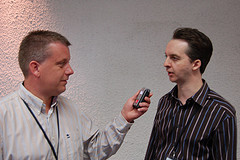 Mike has rented out his advertisement space and is living in wealth now. He doesn’t have to earn his money with writing book anymore, so he’s giving them away. :-) You can download the first chapter of Mike's SRM book at RTFM-Education.
Mike has rented out his advertisement space and is living in wealth now. He doesn’t have to earn his money with writing book anymore, so he’s giving them away. :-) You can download the first chapter of Mike's SRM book at RTFM-Education.
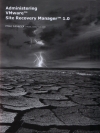 "This book will teach how install and configure VMware's Site Recovery Manager product. It also covers in detail the failover and failback processes - and I will guide you through step-by-step through the setup of the product. This book is not filled with project management padding that typifies a lot of IT books. It's practical and technical, and assumes you are already pretty familiar with VMware's Virtual Infrastructure products including ESX 3.5 and VirtualCenter 2.5. In this book you will learn the strengths and weakness of the Site Recovery Manager product, and show you the common pitfalls and errors that can happen, and also more importantly why they happen, and how to fix them."
"This book will teach how install and configure VMware's Site Recovery Manager product. It also covers in detail the failover and failback processes - and I will guide you through step-by-step through the setup of the product. This book is not filled with project management padding that typifies a lot of IT books. It's practical and technical, and assumes you are already pretty familiar with VMware's Virtual Infrastructure products including ESX 3.5 and VirtualCenter 2.5. In this book you will learn the strengths and weakness of the Site Recovery Manager product, and show you the common pitfalls and errors that can happen, and also more importantly why they happen, and how to fix them."
Update : Mike did it again, another Four Free Chapters from the Vi3Book are online.
Tuesday, February 17. 2009
Support for ESXi and ESXi free in Veeam Backup 3.0
VMware ESX Server version time-line
Did you ever wonder when a particular version of VMware ESX was launched? Well Harold Schoofs, my former colleague at the Kadaster in Apeldoorn has searched through history and created a time-line containing al launched ESX versions. The timeline ends at December 2008, maybe we can add a new version to this timeline next week.
OpsCheck- a free tool to ensure vMotion operation
Server Virtualization Design Module for Lanamark Suite
The new module supports the following platforms: Citrix XenServer, Microsoft Hyper-V, Parallels Virtuozzo Containers, Virtual Iron and VMware ESX. Here is what’s unique about the module:
It provides advanced modeling and side-by-side comparison for a broad set virtualization platforms. Unlike other solutions that focus only on servers and platforms, the module takes into account both technical and commercial dimensions of each solution:
- Hardware, Servers – new, redeployed and upgraded.
- Storage arrays and HBAs since these components dramatically affect the TCO.
- Software licensing costs for virtualization platforms and management software.
- Services (e.g. training, consulting).
The module leverages a rich repository with servers, blade enclosures, storage arrays, HBAs and virtualization software maintained and constantly updated by Lanamark. Based on conversations with Lanamark's customers and partners, it became clear that calculating the number of servers required and balancing workloads across these servers is not enough. What is needed is the ability to design and compare end-to-end server virtualization solutions across virtualization platforms with hardware, software and service components.
